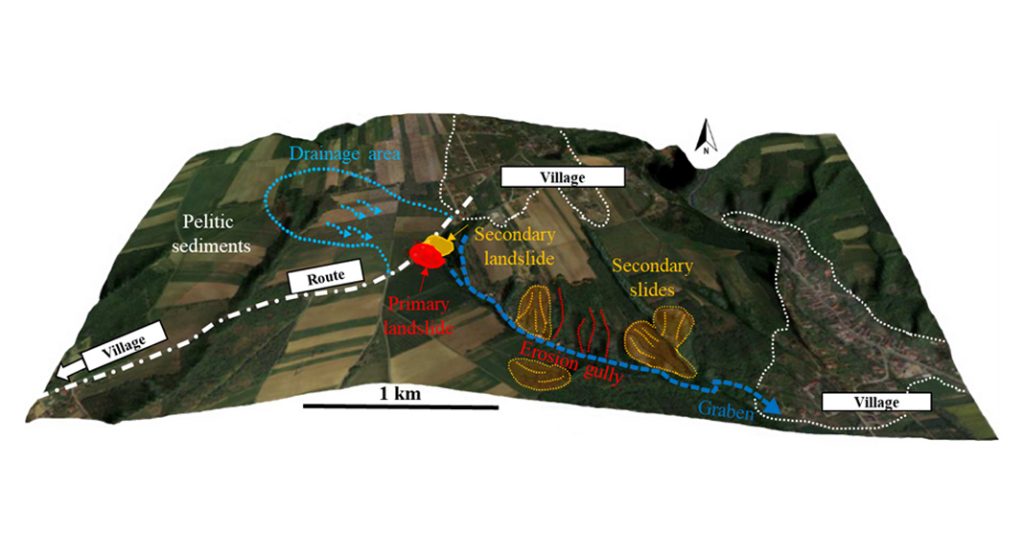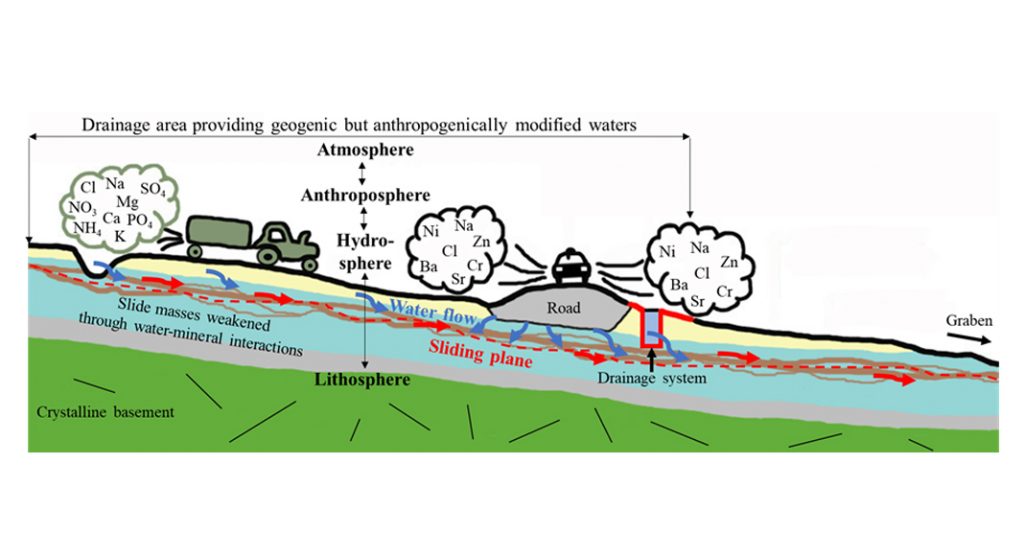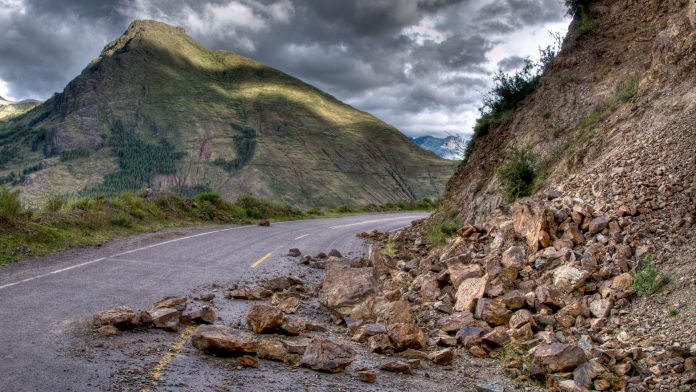Dr Andre Baldermann, Senior Scientist at TU Graz, explains how creeping landslides are initiated and presents a customised engineered solution to help prevent them.
Our dynamic Earth is in steady motion, spanning from sub-atomic scale processes to global events. An important side effect of the complex interactions between the different ‘spheres’ of the Earth, including the atmosphere, anthroposphere, hydrosphere, biosphere, and lithosphere, is the appearance of natural disasters, which can severely impact human beings and our daily lives. While gigantic natural events, like earthquakes, tsunamis, and volcanic eruptions are in the spotlight of current and past scientific investigations, the factors causing the initiation and progression of more local natural phenomena, like continental to submarine landslides, are clearly underexplored.
Landslides are a common form of ground movements on Earth, which are often triggered by local tectonics, surface erosion, chemical and physical weathering of rocks, sediments or soil masses, and gravitational influences, and they are modulated by case-specific hydrological, mineralogical, biological, and geotechnical factors.1-3 The destabilisation of the slide masses through a reduction of shear strength of the formerly stable (under)ground is typically driven by a range of geogenic factors, like heavy rainfalls, groundwater fluctuations, changes in pore (water) pressures and earth eruptions. However various anthropogenic (man-made) factors also frequently result in underground failure and sliding activities, like deforestation, traffic and transportation actions, earthworks, and urbanisation, or a combination of all these potential triggers.
The results are manifold natural disasters, which may express as rock falls, mudflows, debris flows, hillslope deformation and soil liquefaction that may, in all cases, damage critical infrastructure or, in severe cases, cost human life. The economic damage arising from landslides and hillslope debris flows around the world cost billions of euro every year.4

An overlooked hotspot
Advanced knowledge of how the diverse physical, hydrological, anthropogenic, and biochemically-coupled factors initiate landslides is a prerequisite for the development of site-specific conceptual process models and, more importantly, for the realisation of adequate prevention strategies. Unfortunately, more recent concepts are limited to regions possessing a high geohazard potential, like deep-seated gravitational slope deformations or nuclear waste disposal sites, and only a few concepts are focused on urban areas and/or local infrastructure.5 Landslides occurring near highway roads or state roads are an example of such critical but currently overlooked hotspots. In severe cases, episodic deformations taking place in mostly fine-grained sediments require cost-intensive route repair measures, whilst their success is not always guaranteed, if the total system’s behaviour remains partly unknown (see Fig. 1).
Total system assessment
The identification of the interaction mechanisms between geogenic and anthropological factors is the key to understanding our dynamic Earth and, in particular, landslides. Without detailed knowledge provided by engineers, geologists, ecologists, and other Earth Science disciplines, a total system assessment may be difficult to achieve. However, the ‘toolbox’ of Earth scientists is enormous and has continued to rise in recent decades,6 which allows us to make use of multi-methodological approaches that combine, for example, field work to establish terrain models, core logging to define soil-mechanical parameters, analysis of waters and solid matter to understand how weathering and alteration reactions destabilise the underground through the development of sliding horizons over millions of years, and experimental approaches to assess how anthropogenic factors (use of de-icing salts and agricultural fertilisers) can seasonally modify the slide masses.1
In fine-grained sediments, the type and distribution of clay minerals are of fundamental importance to landslides, as they are highly sensitive to variations of the ambient climatic and environmental conditions; a fact that is too often ignored.7 In light of increasing negative effects arising from global warming, like the expected increase in rainstorm intensity,8,9 the site-specific triggering factors causing landslide initiation and progression, as well as the reactivation of dormant mass movements, must be identified to develop customised, engineered solutions for proactive environmental protection (see Fig. 2).

Site-specific solutions and beyond
Very often, small adaptions to the construction of road infrastructure can greatly improve the total system’s behaviour, with the most critical aspect being the design of the de-watering system: the choice of using longitudinal-drainage elements vs cross-drainage elements, for example, controlling the dynamics of the water discharge which subsequently impacts:
- The residence time of the percolating water in the underground;
- The build-up of excess pore water pressure;
- The degree of chemical weathering of the host rocks, sediments, or soils;
- The type and amount of neo-formed clays; and
- The related development of sliding planes.
These are all parameters that influence the shear strength and the slope stability of the slide masses.1
On the other hand, the designers of drainage elements for landslide stabilisation have to consider site-specific physicochemical side effects that eventually result in negative feedback mechanisms, like clogging of the drainage system through the unwanted precipitation of carbonate minerals and iron oxides, if not accounted for appropriately. Future studies may want to make use of the herein presented multi-method approaches and novel landslide prevention strategies to transfer the developed knowledge to an individual landslide case study.
Acknowledgments
This research was funded by the NAWI Graz Geocenter (Graz University of Technology).
References
1 Baldermann, A., Reinprecht, V., & Dietzel, M., 2021. ‘Chemical weathering and progressing alteration as possible controlling factors for creeping landslides’. Sci. Total Environ., 778, 146300
2 Crosetto, M., Copons, R., Cuevas-González, M., Devanthéry, N., Monserrat, O., 2018. ‘Monitoring soil creep landsliding in an urban area using persistent scatterer interferometry (El Papiol, Catalonia, Spain)’. Landslides, 15, 1317-1329
3 Decina, S.M., Templer, P.H., Hutyra, L.R., Gately, C.K., Rao, P., 2017. ‘Variability, drivers, and effects of atmospheric nitrogen inputs across an urban area: emerging patterns among human activities, the atmosphere, and soils’. Sci. Total Environ., 609, 1524-1534
4 Klose, M., Maurischat, P., Damm, B., 2016. ‘Landslide impacts in Germany: a historical and socioeconomic perspective’. Landslides, 13, 183-199
5 Eskandari, M., Homaee, M., Falamaki, A., 2016. ‘Landfill site selection for municipal solid wastes in mountainous areas with landslide susceptibility’. Environ. Sci. Pollut. Res., 23, 12423-12434
6 Rafiei, M., Löhr, S., Baldermann, A., Webster, R., Kong, C., 2020. ‘Quantitative petrographic differentiation of detrital vs diagenetic clay minerals in marine sedimentary sequences: Implications for the rise of biotic soils’. Precamb. Res., 350, 105948
7 Schön, W., Mittermayr, F., Leis, A., Mischak, I., Dietzel, M., 2016. ‘Temporal and spatial variability of chemical and isotopic composition of soil solutions from cambisols – field study and experiments’. Sci. Total Environ., 572, 1066-1079
8 Stoffel, M., Tiranti, D., Huggel, C., 2014. ‘Climate change impacts on mass movements – case studies from the European Alps’. Sci. Total Environ., 493, 1255-1266
9 Pisano, L., Zumpano, V., Malek, Ž., Rosskopf, C.M., Parise, M., 2017. ‘Variations in the susceptibility to landslides, as a consequence of land cover changes: a look to the past, and another towards the future’. Sci. Total Environ., 601-602, 1147-1159
Please note, this article will also appear in the sixth edition of our quarterly publication.







